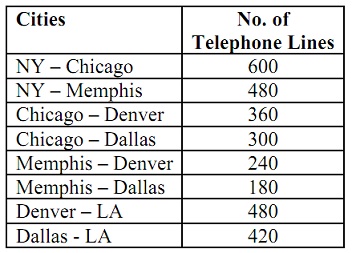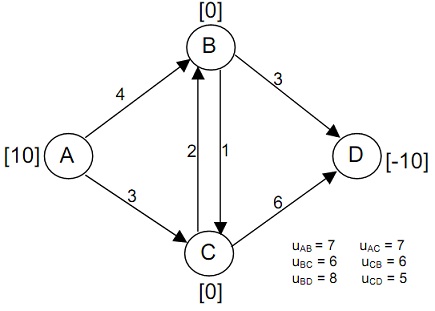Problem 1:
Telephone calls from New York to Los Angeles are transported as follows: The call is sent first to either Chicago or Memphis, then routed through either Denver or Dallas, and finally sent to Los Angeles. The number of phone lines joining each pair of cities is shown in table shown below.
a) Formulate an LP that can be used to determine the maximum number of calls that can be sent from New York to Los Angeles at any given time.
b) Use the algorithm shown in class to determine the maximum number of calls that can be sent from New York to Los Angeles at any given time.
c) Use the fanning out procedure to show that the solution you obtained in (b) is optimal.
d) Use the max-flow min-cut theorem to show that the solution you obtained in (b) is optimal.
e) Solve the problem using an Excel spreadsheet.

Problem 2:
Oilco has oil fields in San Diego and Los Angeles. The San Diego field can produce 600,000 barrels per day, and the Los Angeles field can produce 500,000 barrels per day. Oil is sent from the fields to a refinery, in either Dallas or Houston (assume each refinery has unlimited capacity). To refine 100,000 barrels costs $800 at Dallas and $1,000 at Houston. Refined oil is shipped to customers in Chicago and New York. Chicago customers require 500,000 barrels per day and New York customers require 400,000 barrels per day. The costs of shipping 100,000 barrels of oil (refined or unrefined) between cities are shown in table shown below. Not more than 400,000 barrels per day can be shipped between any two cities.
a) Formulate a feasible minimum cost flow problem that can be used to determine how to minimize the total cost of meeting all demands. Provide both a network representation of the problem and an LP formulation.
b) Solve the problem using an Excel spreadsheet.

Problem 3:
Consider the minimum cost network flow problem shown in Figure shown below, where the bi values (net flow generated) are given by the nodes, the cij values (costs per unit flow) are given by the arcs, and the uij values (arc capacities) are given on the side of the figure.

a) Obtain an initial basic feasible solution by solving the feasible spanning tree with basic arcs A → B, A → C and B → D where one of the non basic arcs (D → C) is a reverse arc. Show the resulting network (including bi, cij and uij) in the same format as the one in the Figure (except use dashed lines to draw the non basic arcs), and add the flows in parentheses next to the basic arcs.
b) Use this initial solution to apply the network simplex method and solve this problem. What is the optimal flow allocation?